By Katie Nichols
AUBURN UNIVERSITY, Ala. — Although the summer weather pattern in the state is on par with the standard, the late summer update remains the same for Alabama crops—it’s all over the board.
Some areas of the state have received ample rainfall, while others have had sporadic showers. There are also those with an in-between situation. In addition, there is recent talk of insecticide shortages and difficulty finding desired products. Alabama Cooperative Extension System regional agents and specialists have been paying close attention to weather patterns and crop situations across the state in order to provide Alabama farmers with timely, relevant information.
Insecticide Shortages
Scott Graham, an Alabama Extension cotton, soybean and peanut entomologist, said he is starting to hear about insecticide shortages, while other products are difficult to find. Up to this point, producers have been able to get the products they wanted, but now some products are running short.
“In situations where farmers cannot get the chemicals they want, it will be important to make sure what they are able to get will do the job,” Graham said. “In other words, make sure the second (or third) option has activity on the target pest and will provide adequate control.”
Alabama Crops Update
North Alabama
Extension Agronomist Tyler Sandlin, is based in the Tennessee Valley. He said corn is definitely the hardest hit crop in north Alabama because of persistent drought and heat stress during critical reproductive stages.
“Some acres may not have a combine run through the field,” Sandlin said. “A lot of growers will likely hope to break even on other corn acres. There are a few dryland fields that may have respectable yields, but they are few and far between.”
Sandlin said a lot of full-season soybeans are in the same boat as corn. Recent late rains will help to mitigate some of the early drought damage, but there are still challenges. These late rains do have the potential to help out double-cropped soybean acres planted behind wheat.
“It just depends on where the rain has been falling and how much,” he said. “It’s truly a mixed bag.”
Cotton seems to have the most potential right now. There are still plenty of drought-challenged acres, but many areas have had recent rains that will go a long way towards having respectable yields.
“Likely no bumper crop in the majority of areas in north Alabama, however there is still strong yield potential for a lot of acres,” Sandlin said.
East Central Alabama
Andrew Sparks, an Alabama Extension regional crops agent in east Alabama, said overall, cotton and peanuts are looking strong. However, he said each field and location varies.
“This is the year of irrigation for corn,” Sparks said. “If you have irrigated corn, you will be okay, but dryland corn is really struggling. Unfortunately dryland will be marginal—at best—and irrigated seems average right now.”
Sparks said armyworms are moving into parts of east Alabama, and he expects numbers to rise in the coming weeks.
West Central Alabama
Another regional crops agent, John Vanderford, serves west central Alabama. He, too, sees some armyworm pressure and is expecting it to intensify. Peanuts in west central Alabama have lapped, and producers are not seeing much disease pressure. Timely fungicide applications are going out and producers will be checking maturity in early September.
He said the cotton crop is all over the board—much like the rainfall in the area.
“Some areas received good beneficial rain events throughout July and early August and many areas have received none or very little,” Vanderford said. “Some fields are loading up great and are carrying a lot of potential. Other fields are struggling, but we hope for some rain and a good harvest.”
Corn harvest is underway in west Alabama for a few growers.
“With the lack of rain in June and throughout the growing season in many areas, the corn crop has taken a blow,” Vanderford said. “Add the fertilizer prices and other increased input costs, trucking, shortages and hog pressure and it has been a difficult year. Farmers continue to find ways to push through and make things happen, but this year has been a challenge.”
Vanderford said he has talked to a few growers who have questioned whether to combine certain fields or not because they are toast but not across the board.
Southwest Alabama
Regional crops agent Guilherme Morata said the southwest region of the state is in a different situation than much of the rest of the state.
“We have been receiving a lot of rainfall events in the past month,” Morata said. “In south Baldwin County, we have had 25 days of rainfall out of 31 days in July with a total of about 14 inches.”
So far, he said corn looks good. Some growers began harvest last week, and yields are fair to good. Some of the late-planted corn suffered more than the others because of the high temperatures during tasseling stage. In terms of diseases, Southern corn rust was identified but most growers sprayed at least one time with fungicide.
“However, the other crops such as cotton, peanuts and soybeans are struggling with the amount of rainfall, and it is very common to see water logging in many fields,” Morata said. “Growers are having hard time spraying in a timely manner the fields. As a result, diseases, insect damage and weeds are easy to find in the region.”
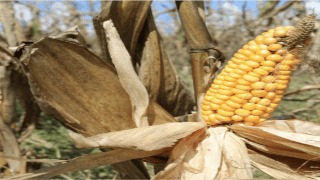
Drought-stressed dryland corn

White cotton bloom
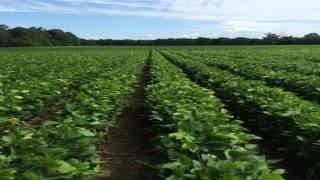
Soybeans in Alabama
Statewide Cotton Update
Steve Brown, an Alabama Extension cotton agronomist, said the cotton-growing areas of Alabama are extremely diverse; therefore, conditions and yield prospects vary widely.
“Most of our summer rains have been pop-up showers rather than broad weather fronts, so even within the same regions of the state, we see the haves and have-nots,” he said. “In the past couple of weeks, I’ve been in fields with excellent potential, particularly across the central part of the state.”
Altogether, Brown said the 2022 cotton crop has significant potential.
“It will be an early crop in most areas,” Brown said. “I’m optimistic, but recognize the last 40 days before harvest have a profound impact on final yields.”
Statewide Corn and Soybean Update
Eros Francisco, an Alabama Extension grains specialist, said soybeans are blooming (south) to filling pods (north), and rain has been an issue in some areas, especially north Alabama.
“So far, yield has not been impacted as much as corn yield has,” Francisco said. “Kudzu bugs have been found everywhere and may have left some impact in certain fields. Currently, it is time to monitor stink bugs and control them accordingly.”
Francisco, who is also an assistant professor in the Auburn University College of Agriculture’s crop, soil and environmental sciences department, said corn has been the most impacted crop by June’s drought and heat so far, mostly in the Tennessee Valley area.
“In many cases, dryland corn yield will range between 50 and 100 bushels per acre,” Francisco said. “Even irrigated corn has suffered with heat in the north once temperatures reached 100 or so degrees for several days in a row.”
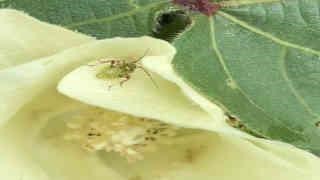
Immature tarnished plant bug
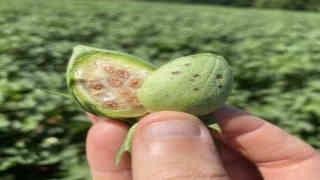
Stinkbug damage to a cotton boll
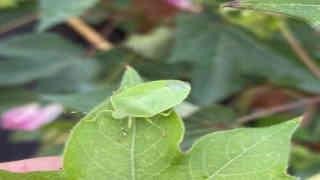
Green stink bug
Statewide Insect Update
Cotton
Graham said the Alabama cotton insect situation is an evolving system. This year has driven home the need for boots on the ground and someone scouting fields.
“Normally this time of the year, stink bugs are the dominate insect issue,” Graham said. “This year however, we are still getting a lot of reports of plant bugs, both tarnished and clouded, in fields at economic levels statewide (tarnished being the dominate species of the two). In many cases, the insect situation changes from field to field and region to region.”
While the crop looks good in some areas, the drought conditions in parts of the Wiregrass and Tennessee Valley have caused farmers to fight spider mites nearly all season long. In some cases, one spray has done the job, but some fields have required multiple applications to keep mites in check.
Soybeans
Over the past two to three weeks there has been an explosion of kudzu bugs, but recent days have shown a much more pressing problem with redbanded stinkbug infestations in the Black Belt region.
“Currently, our older beans, or those that are filling pods, are at a higher risk,” Graham said. “As the season continues, our later planted beans will likely receive higher infestations as they are the only game in town.”
He said these populations won’t reach every acre across the state. However, there is potential to really cause damage across central and south Alabama. Farmers and field advisors across these regions should be on alert for this damaging species. Graham will be putting out information as quickly as he receives it to keep people as informed as possible.
“We are also starting to hear more about a complex of defoliators in fields including soybean loopers, velvetbean caterpillars, green cloverworms and some odd balls like Southern armyworms,” Graham said. “Scouting and proper identification is key to economical management, because of the differing insecticide tolerances each pest has.”
Peanuts
Overall, peanuts have been quiet this year. Thrips were tough in some fields, particularly those planted in late April or early May.
“Like with soybeans, we are beginning to hear a little bit about defoliating caterpillars in fields but overall, we seem to be in good shape there,” Graham said. “Spider mites are a concern in some fields in the Wiregrass.”
Source : aces.edu